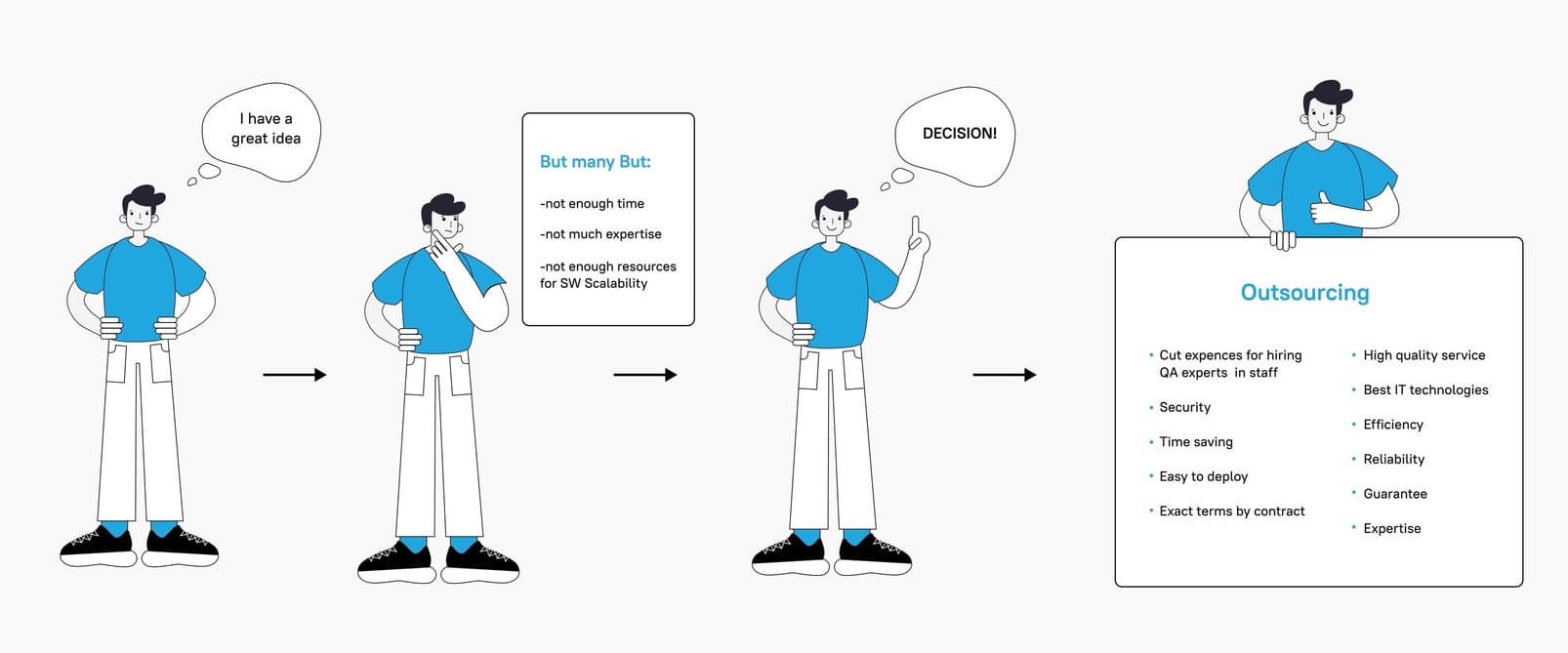Software testing is a critical component of the software development lifecycle. It helps companies identify mistakes and errors made during development and allows them to eliminate these mistakes before deployment.
However, inexperienced testing staff can miss errors during software testing. Since resolving software issues and bugs after the deployment is not only difficult but also more time-consuming and costly, any mistakes made by your staff can cause significant losses for your business.
To save time and money, outsourcing software testing is the most efficient option. Software testing led by outsourced experts can uncover both major and minor faults within your application, ensuring its successful implementation.
Nevertheless, finding the optimal outsourced software testing service is another challenge on its own. In this article, we will outline the software testing outsourcing guide for your organization.
Why Is Outsourcing a Software Testing Company Necessary?
While some people think that outsourcing software testing results in greater costs for companies than in-house teams, the reality is far from it. In-house development incurs additional expenses due to infrastructure, operational, and HR costs.
If your in-house professionals are inexperienced and don’t have the relevant knowledge to take care of unforeseen issues during testing, they will take more time to understand problems and expend more resources in resolving them. At the same time, the process of hiring software testers takes considerable time and delays the testing procedure.
An outsourced testing service excels in terms of expertise, as well. Their technical experience in multiple fields enables them to identify problems in software more efficiently and in less time. Similarly, their knowledge from various fields can maintain software quality according to user expectations.
Unless software testing is a core competency of your company, it can be a huge challenge for your company to perform it correctly in-house. Instead of solving the problem, your staff can create more problems because of their lack of knowledge of software testing practices.
Choosing an outsourced software testing service can help make your end product more competitive and ultimately drive additional customers. With that said, you should only consider outsourcing to a software testing company that has relevant technical expertise and experience.
Goals and Expectations for Outsourcing Testing
While there are many benefits of relying on outsourced services for software testing, there are many challenges as well. Unlike your in-house team, the offshore is not working in the vicinity, making it difficult for companies to coordinate. However, prioritizing software testing goals and expectations with QA testing outsourcing can assist companies in getting around these challenges.
Expedite Bug Detection
Understandably, the goal of outsourcing software testing is to expose vulnerabilities in applications. After outsourcing testing, you must be able to detect and root out software malfunctions and bugs before they degrade the user experience.
Improve Bug Prevention
Aside from detecting software bugs, outsourced testing must prevent defects in a solution at the earliest stage of its development. It’s common knowledge that the earlier you detect a bug in an application, the less cost you’ll have to pay for it.
According to research by IBM, resolving bugs during implementation costs six times more than bug prevention in the design stage. At the same time, bug prevention shortens the product’s time to market. For this reason, bug prevention at all stages of software development is another important goal of hiring outsourced software testing services.
Enhance Software Quality, Availability, and User Satisfaction
Performance testing outsourcing and application testing outsourcing are some of the foremost goals of outsourced testing. In performance testing, outsourced software testers must evaluate the application’s performance against varying user loads. Similarly, in application testing, the QA team must ensure that the product meets user requirements and functions as desired.
Both forms of testing are necessary to maximize user satisfaction and ensure the availability of the solution at peak hours of usage. At the same time, both tests are necessary to make sure that the application meets user expectations and performs reliably under all conditions.
Ensure Software Compatibility
Software compatibility is an application’s ability to work in line with other software, hardware, or network specifications. This can include desktop, web, and mobile platform types, different kinds of operating systems, as well as web browsers. A software testing outsourcing partner needs to conduct software compatibility tests to ensure that the solution works well in all conditions.
Prepare Your Staff and Workflows
After setting the goals of testing, it’s necessary to prepare your staff and workflow for optimal performance with outsourced software testing services.
Streamlining Workflows
When you are relying on an outsourced software testing agency, it’s necessary to streamline your workflows in the beginning. In terms of testing, the major touchpoints between you and your software testing outsourcing partner are existing and modified code, detected bugs, error resolution, and the fulfillment of software requirements specification.
All these touchpoints are essential to the success of your application. This is why it’s necessary to clarify at the beginning where all the information related to these touchpoints is stored. Similarly, you should establish a guideline regarding how often this information is updated.
Another important factor during testing is the tools and techniques used by your software team. This includes the development environment, tools used for source code management, as well as software and platforms used for continuous integration. At the same time, you should finalize the bug-reporting procedures you prefer so you don’t have to invest time in learning new procedures.
As a software tester, you must accept the fact complete compliance with all QA aspects and ideal development processes are not always possible. That said, the more information you provide outsourced testing vendors, the less time it will take to formalize your partnership.
Dedicate a Senior QA manager
Although outsourced software testing teams hold well on their own, it’s always good to dedicate a senior QA professional from your in-house testing team. Many outsourced testing teams have as many as fifty software testers. Dedicating an in-house resource helps you to coordinate and cooperate with a testing service more effectively.
At the same time, your senior QA manager can act as a mediator between your in-house development team and outsourced vendor. Being a part of your organization, he or she can independently assess, manage, and give useful feedback to outsourced partners.
Preach Cooperation with the Outsourced Testing Team
Aligning development and testing is a crucial step in using outsourced software testing services. In most cases, development teams and external testers lack coordination and are not able to communicate openly and freely.
This lack of communication leads to late updates to test plans, unclear bug reports, and poor understanding of application requirements. As a result, both teams ultimately miss iteration goals and deadlines. This is why senior managers should make sure that both teams work with complete cooperation and mutual understanding.
Choose Your Right Software Testing Outsourcing Partner
There are many factors you must consider to choose the right software testing outsourcing partner, some of which are as follows:
Reliability and Expertise
The first and foremost thing you should look for is the reliability and expertise of a software testing service. The best way of doing so is to review the references and case studies a software testing service has.
A reliable software testing service respects test documentation. However, they also provide prospective clients with easy access to the templates of their test artifacts. Similarly, you can evaluate the competence of outsourced software testing by the amount of international QA testing certificates they have acquired. Likewise, adherence to data quality, security regulations, and testing standards (such as PCI DSS HIPAA, ISO/IEC/IEEE 29119, and ISO9001:2015) speak volumes about a company’s commitment to quality.
Sufficient Testing Resources and Services
An outsourced testing service should have a surplus of testing resources available. Aside from outsourcing automated testing, you should be able to ask for all kinds of software testing services, whether it’s manual, desktop, mobile, web, performance, functional, security usability, compatibility, or API testing.
Efficient Management
The main purpose of outsourcing QA testing is to cut down time-consuming tasks from your workflow and relay them to the outsourcing testing partner. Unless the testing service is dedicated to high-level management of all testing tasks and procedures, it can be difficult for them to keep up with your testing requirements.
Assessing and Managing the Vendor Regularly
Although choosing the right outsourcing testing partner does most of your job, you still need to assess and manage the vendor diligently. That said, it’s also important to consider the following factors while assessing your vendors.
Keep Realistic Expectations and Cooperate
Outsourced Testing vendors are under constant pressure from talent acquisition challenges, operational costs, other projects they are working with. In such scenarios demanding excessive discounts can affect resource allocation to your software projects.
Like any company, these companies will cut their expenses in other ways if they are forced to give excessive discounts. Some may assign junior staff to cope with reduced pricing, while others may cut resources.
Simultaneously, it’s essential to share necessary information with testing services as long as they are a part of your NDA. Closure with key information can improve the quality of testing as it helps them understand user expectations, specific technical requirements business, and objectives more effectively.
Regularly Assess Testing Services
It’s extremely necessary to assess the performance of your testing service with respect to the billing criteria and their most relevant performance. You can evaluate them based on the number of missed bags, the correlation between testing outcomes and efforts, the quality of test documentation, and defect description. Your senior in-house QA manager can play a major role in evaluating their performance concerning more relevant KPIs.
Manage Vendor Performance
To maintain or improve the quality of QA testing services, your QA manager has to supervise testing processes closely and review testing documentation at least one time each month. Unless the manager instructs the team regularly, gives them testing feedback, or aligns your development team with the testing team, the testing process can get clogged.
You should ensure constant communication between your QA manager and the testing vendor. For instance, if the correlation between testing efforts and outcomes has been insufficient, then your manager should convey the company’s reservations to the testing vendor promptly. Direct coordination and streamlined communication can eliminate misunderstandings significantly and ensure the quality of software.
Solving Issues with Outsourcing Testing Service
Regardless of how dedicated and effective a testing service is, some problems can crop up unexpectedly, here’s how what you can do.
Handling Software Requirements Changes
One of the most challenging issues for outsourced software testing teams is handling Agile projects, where software requirements are updated and changed routinely. Many times, outsourced services create iteration test plans, test cases, and test environments only to get informed that they have to do it from scratch because the client has revised their requirements. Effective software requirements management can help streamline this process by ensuring that all changes are clearly documented, prioritized, and communicated.
To stop problems from getting worse, you must ensure seamless communication between your team and external test teams. One of the better ways to handle this is to instruct your in-house QA manager to organize daily goals’ settings in a shared medium and conduct weekly video conferences synchronizing testing and development efforts.
Losing Focus on Testing
In complex software development projects, it’s common for outsourced testing services to be troubled by constantly changing priorities. Because of this many external teams occasionally push critical software features out of their testing scope in a bid to keep up with immediate testing problems.
To counter such scenarios, in-house QA managers need to help external test teams develop a clear test plan for every iteration. Aside from that, teams can leverage exploratory and risk-based testing to prioritize tasks so they can address critical features first.
Develop an Agreement with the QA vendor
Developing a QA outsourcing contract is the legal foundation of all cooperation between your in-house and external teams. It outlines the method to deliver testing services in an organized manner. It’s necessary for both you and your vendor to create the contract based on a clear set of testing objectives, metrics, and milestones.
That said, most QA outsourcing contracts are valid for as much as 5 to 10 years. In such circumstances, your in-house QA managers may find it difficult to manage Agile testing requirements with general QA outsourcing contract components.
This is why it’s necessary to include various Service Level Agreements (SLAs) in these contracts to relay all testing conditions into different, manageable parts. Every SLA can be dedicated to different components of the outsourced testing service, making it possible to formalize testing agreements for different kinds of testing, including Agile.
Outsourcing Software Testing in PFLB
Small problems in software structure and design can cause significant issues in its application. Several obstacles, which include delayed response time, poor usability, and downtime can cause significant losses to a business.
To prevent such problems from affecting your business, you need to consider having early testing phase in sdlc to ensure that no error remains after the software deployment.
PFLB is one of the pioneer software testing service providers in the industry. Since its inception, the company has been providing software testing services to over 500 companies across all domains, from finance and healthcare to retail and technology. The company provides its clients with core e-commerce web testing services, ranging from reliable Performance Testing, Usability Testing, and Mobile Testing to Integration Testing, Test Automation, and much more.




